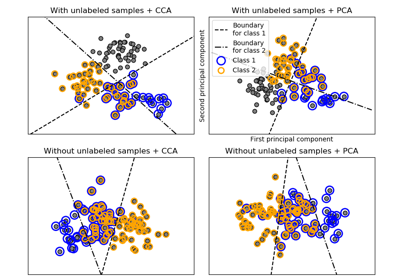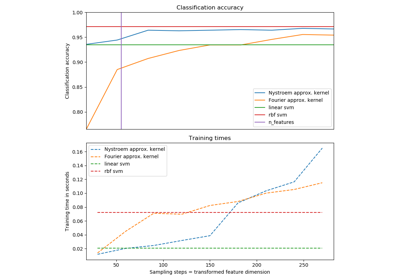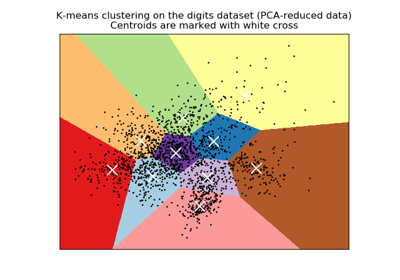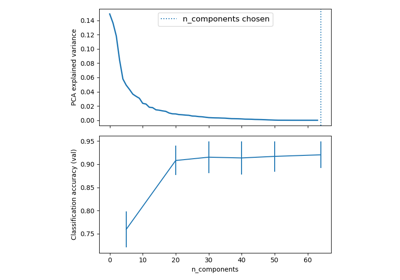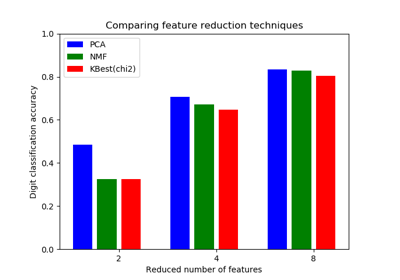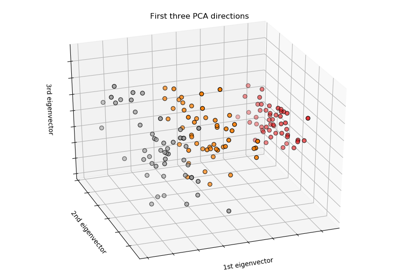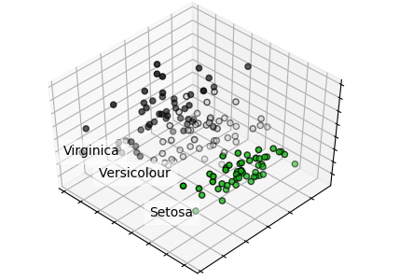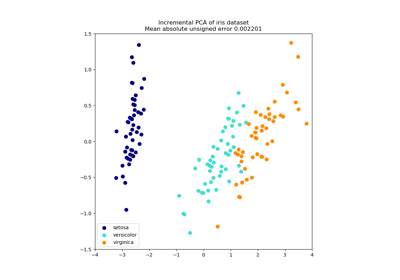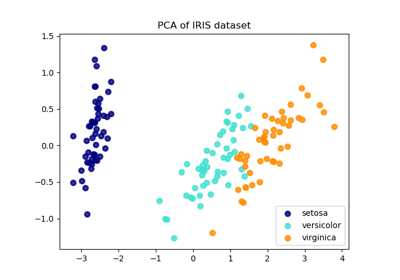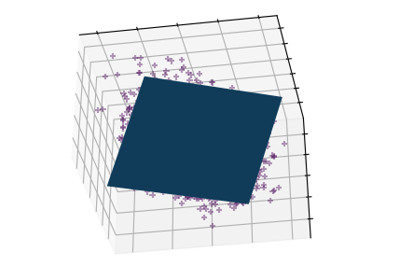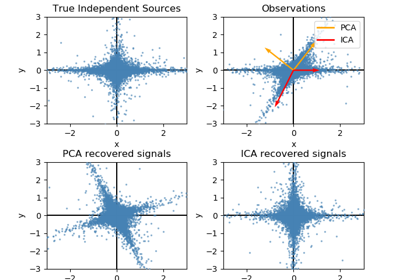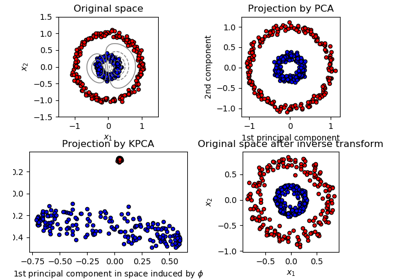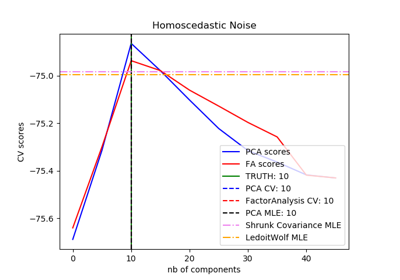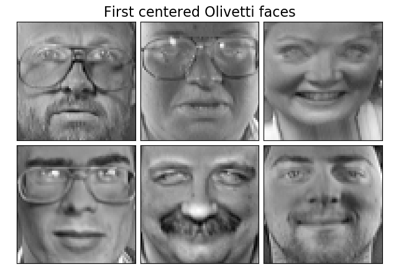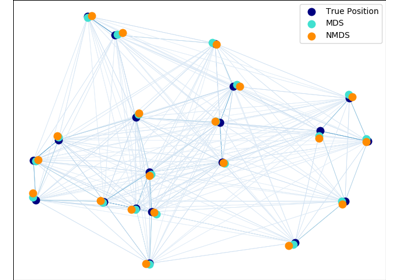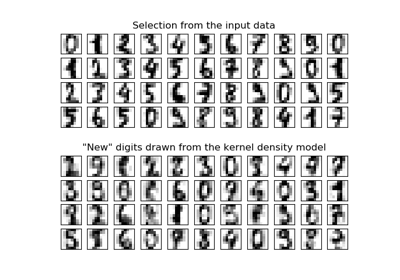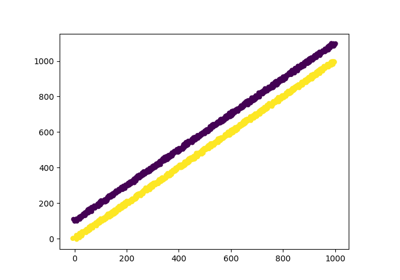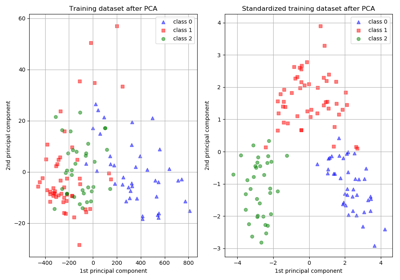sklearn.decomposition.PCA¶
-
class
sklearn.decomposition.PCA(n_components=None, copy=True, whiten=False, svd_solver=’auto’, tol=0.0, iterated_power=’auto’, random_state=None)[source]¶ Principal component analysis (PCA)
Linear dimensionality reduction using Singular Value Decomposition of the data to project it to a lower dimensional space.
It uses the LAPACK implementation of the full SVD or a randomized truncated SVD by the method of Halko et al. 2009, depending on the shape of the input data and the number of components to extract.
It can also use the scipy.sparse.linalg ARPACK implementation of the truncated SVD.
Notice that this class does not support sparse input. See
TruncatedSVDfor an alternative with sparse data.Read more in the User Guide.
Parameters: - n_components : int, float, None or string
Number of components to keep. if n_components is not set all components are kept:
n_components == min(n_samples, n_features)
If
n_components == 'mle'andsvd_solver == 'full', Minka’s MLE is used to guess the dimension. Use ofn_components == 'mle'will interpretsvd_solver == 'auto'assvd_solver == 'full'.If
0 < n_components < 1andsvd_solver == 'full', select the number of components such that the amount of variance that needs to be explained is greater than the percentage specified by n_components.If
svd_solver == 'arpack', the number of components must be strictly less than the minimum of n_features and n_samples.Hence, the None case results in:
n_components == min(n_samples, n_features) - 1
- copy : bool (default True)
If False, data passed to fit are overwritten and running fit(X).transform(X) will not yield the expected results, use fit_transform(X) instead.
- whiten : bool, optional (default False)
When True (False by default) the components_ vectors are multiplied by the square root of n_samples and then divided by the singular values to ensure uncorrelated outputs with unit component-wise variances.
Whitening will remove some information from the transformed signal (the relative variance scales of the components) but can sometime improve the predictive accuracy of the downstream estimators by making their data respect some hard-wired assumptions.
- svd_solver : string {‘auto’, ‘full’, ‘arpack’, ‘randomized’}
- auto :
the solver is selected by a default policy based on X.shape and n_components: if the input data is larger than 500x500 and the number of components to extract is lower than 80% of the smallest dimension of the data, then the more efficient ‘randomized’ method is enabled. Otherwise the exact full SVD is computed and optionally truncated afterwards.
- full :
run exact full SVD calling the standard LAPACK solver via scipy.linalg.svd and select the components by postprocessing
- arpack :
run SVD truncated to n_components calling ARPACK solver via scipy.sparse.linalg.svds. It requires strictly 0 < n_components < min(X.shape)
- randomized :
run randomized SVD by the method of Halko et al.
New in version 0.18.0.
- tol : float >= 0, optional (default .0)
Tolerance for singular values computed by svd_solver == ‘arpack’.
New in version 0.18.0.
- iterated_power : int >= 0, or ‘auto’, (default ‘auto’)
Number of iterations for the power method computed by svd_solver == ‘randomized’.
New in version 0.18.0.
- random_state : int, RandomState instance or None, optional (default None)
If int, random_state is the seed used by the random number generator; If RandomState instance, random_state is the random number generator; If None, the random number generator is the RandomState instance used by np.random. Used when
svd_solver== ‘arpack’ or ‘randomized’.New in version 0.18.0.
Attributes: - components_ : array, shape (n_components, n_features)
Principal axes in feature space, representing the directions of maximum variance in the data. The components are sorted by
explained_variance_.- explained_variance_ : array, shape (n_components,)
The amount of variance explained by each of the selected components.
Equal to n_components largest eigenvalues of the covariance matrix of X.
New in version 0.18.
- explained_variance_ratio_ : array, shape (n_components,)
Percentage of variance explained by each of the selected components.
If
n_componentsis not set then all components are stored and the sum of the ratios is equal to 1.0.- singular_values_ : array, shape (n_components,)
The singular values corresponding to each of the selected components. The singular values are equal to the 2-norms of the
n_componentsvariables in the lower-dimensional space.- mean_ : array, shape (n_features,)
Per-feature empirical mean, estimated from the training set.
Equal to X.mean(axis=0).
- n_components_ : int
The estimated number of components. When n_components is set to ‘mle’ or a number between 0 and 1 (with svd_solver == ‘full’) this number is estimated from input data. Otherwise it equals the parameter n_components, or the lesser value of n_features and n_samples if n_components is None.
- noise_variance_ : float
The estimated noise covariance following the Probabilistic PCA model from Tipping and Bishop 1999. See “Pattern Recognition and Machine Learning” by C. Bishop, 12.2.1 p. 574 or http://www.miketipping.com/papers/met-mppca.pdf. It is required to compute the estimated data covariance and score samples.
Equal to the average of (min(n_features, n_samples) - n_components) smallest eigenvalues of the covariance matrix of X.
See also
References
For n_components == ‘mle’, this class uses the method of Minka, T. P. “Automatic choice of dimensionality for PCA”. In NIPS, pp. 598-604
Implements the probabilistic PCA model from: `Tipping, M. E., and Bishop, C. M. (1999). “Probabilistic principal component analysis”. Journal of the Royal Statistical Society: Series B (Statistical Methodology), 61(3), 611-622. via the score and score_samples methods. See http://www.miketipping.com/papers/met-mppca.pdf
For svd_solver == ‘arpack’, refer to scipy.sparse.linalg.svds.
For svd_solver == ‘randomized’, see: Halko, N., Martinsson, P. G., and Tropp, J. A. (2011). “Finding structure with randomness: Probabilistic algorithms for constructing approximate matrix decompositions”. SIAM review, 53(2), 217-288. and also Martinsson, P. G., Rokhlin, V., and Tygert, M. (2011). “A randomized algorithm for the decomposition of matrices”. Applied and Computational Harmonic Analysis, 30(1), 47-68.
Examples
>>> import numpy as np >>> from sklearn.decomposition import PCA >>> X = np.array([[-1, -1], [-2, -1], [-3, -2], [1, 1], [2, 1], [3, 2]]) >>> pca = PCA(n_components=2) >>> pca.fit(X) PCA(copy=True, iterated_power='auto', n_components=2, random_state=None, svd_solver='auto', tol=0.0, whiten=False) >>> print(pca.explained_variance_ratio_) [0.9924... 0.0075...] >>> print(pca.singular_values_) [6.30061... 0.54980...]
>>> pca = PCA(n_components=2, svd_solver='full') >>> pca.fit(X) PCA(copy=True, iterated_power='auto', n_components=2, random_state=None, svd_solver='full', tol=0.0, whiten=False) >>> print(pca.explained_variance_ratio_) [0.9924... 0.00755...] >>> print(pca.singular_values_) [6.30061... 0.54980...]
>>> pca = PCA(n_components=1, svd_solver='arpack') >>> pca.fit(X) PCA(copy=True, iterated_power='auto', n_components=1, random_state=None, svd_solver='arpack', tol=0.0, whiten=False) >>> print(pca.explained_variance_ratio_) [0.99244...] >>> print(pca.singular_values_) [6.30061...]
Methods
fit(X[, y])Fit the model with X. fit_transform(X[, y])Fit the model with X and apply the dimensionality reduction on X. get_covariance()Compute data covariance with the generative model. get_params([deep])Get parameters for this estimator. get_precision()Compute data precision matrix with the generative model. inverse_transform(X)Transform data back to its original space. score(X[, y])Return the average log-likelihood of all samples. score_samples(X)Return the log-likelihood of each sample. set_params(**params)Set the parameters of this estimator. transform(X)Apply dimensionality reduction to X. -
__init__(n_components=None, copy=True, whiten=False, svd_solver=’auto’, tol=0.0, iterated_power=’auto’, random_state=None)[source]¶
-
fit(X, y=None)[source]¶ Fit the model with X.
Parameters: - X : array-like, shape (n_samples, n_features)
Training data, where n_samples is the number of samples and n_features is the number of features.
- y : Ignored
Returns: - self : object
Returns the instance itself.
-
fit_transform(X, y=None)[source]¶ Fit the model with X and apply the dimensionality reduction on X.
Parameters: - X : array-like, shape (n_samples, n_features)
Training data, where n_samples is the number of samples and n_features is the number of features.
- y : Ignored
Returns: - X_new : array-like, shape (n_samples, n_components)
-
get_covariance()[source]¶ Compute data covariance with the generative model.
cov = components_.T * S**2 * components_ + sigma2 * eye(n_features)where S**2 contains the explained variances, and sigma2 contains the noise variances.Returns: - cov : array, shape=(n_features, n_features)
Estimated covariance of data.
-
get_params(deep=True)[source]¶ Get parameters for this estimator.
Parameters: - deep : boolean, optional
If True, will return the parameters for this estimator and contained subobjects that are estimators.
Returns: - params : mapping of string to any
Parameter names mapped to their values.
-
get_precision()[source]¶ Compute data precision matrix with the generative model.
Equals the inverse of the covariance but computed with the matrix inversion lemma for efficiency.
Returns: - precision : array, shape=(n_features, n_features)
Estimated precision of data.
-
inverse_transform(X)[source]¶ Transform data back to its original space.
In other words, return an input X_original whose transform would be X.
Parameters: - X : array-like, shape (n_samples, n_components)
New data, where n_samples is the number of samples and n_components is the number of components.
Returns: - X_original array-like, shape (n_samples, n_features)
Notes
If whitening is enabled, inverse_transform will compute the exact inverse operation, which includes reversing whitening.
-
score(X, y=None)[source]¶ Return the average log-likelihood of all samples.
See. “Pattern Recognition and Machine Learning” by C. Bishop, 12.2.1 p. 574 or http://www.miketipping.com/papers/met-mppca.pdf
Parameters: - X : array, shape(n_samples, n_features)
The data.
- y : Ignored
Returns: - ll : float
Average log-likelihood of the samples under the current model
-
score_samples(X)[source]¶ Return the log-likelihood of each sample.
See. “Pattern Recognition and Machine Learning” by C. Bishop, 12.2.1 p. 574 or http://www.miketipping.com/papers/met-mppca.pdf
Parameters: - X : array, shape(n_samples, n_features)
The data.
Returns: - ll : array, shape (n_samples,)
Log-likelihood of each sample under the current model
-
set_params(**params)[source]¶ Set the parameters of this estimator.
The method works on simple estimators as well as on nested objects (such as pipelines). The latter have parameters of the form
<component>__<parameter>so that it’s possible to update each component of a nested object.Returns: - self
-
transform(X)[source]¶ Apply dimensionality reduction to X.
X is projected on the first principal components previously extracted from a training set.
Parameters: - X : array-like, shape (n_samples, n_features)
New data, where n_samples is the number of samples and n_features is the number of features.
Returns: - X_new : array-like, shape (n_samples, n_components)
Examples
>>> import numpy as np >>> from sklearn.decomposition import IncrementalPCA >>> X = np.array([[-1, -1], [-2, -1], [-3, -2], [1, 1], [2, 1], [3, 2]]) >>> ipca = IncrementalPCA(n_components=2, batch_size=3) >>> ipca.fit(X) IncrementalPCA(batch_size=3, copy=True, n_components=2, whiten=False) >>> ipca.transform(X)


